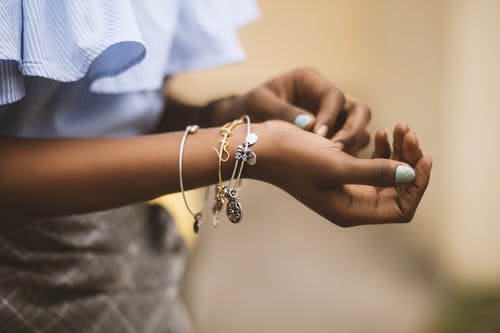Having a skin allergy is one of the most annoying problems a jewelry lover can have. There are various different kinds of skin allergies, some of which include being sensitive to specific fabrics, chemicals, and natural elements in the environment. The most common among skin irritants are specific types of metal. This means that not all of us can wear just any kind of jewelry we like, especially if it’s costume jewelry.
Being allergic or sensitive to certain types of metal can make it difficult for a person to choose and wear jewelry. If you’re one of those people who are suffering from annoying rashes when wearing jewelry, then hypoallergenic jewelry might work for you. However, how would you know which ones you can wear without any problem? No worries, because we are here to give you tips about hypoallergenic jewelry pieces.
Of course, you first need to figure out when and why you would need hypoallergenic jewelry. You have to be careful here, as it might take a fair bit of effort to find the right jewelry for your needs. Read on to find out how you can deduce that you have a jewelry allergy and what hypoallergenic jewelry entails:
How to Know If You Have an Allergies to Jewelry
It’s easy to determine if you are experiencing an allergy to jewelry. Some of the signs and symptoms are itchy and red skin, rash, swelling, burning, and blisters at the site of contact. If you’re feeling some of these symptoms every time you wear jewelry, you most likely have an allergy to the material or some other component of those pieces. Sometimes, you might notice that wearing a certain piece of jewelry in a hot and humid environment might increase the chances of rashes.
Another way is to conduct scratch tests from a professional jeweler or conduct your own test at home. If you learn to do it right, you can decide what metals and jewelry pieces you should avoid. For example, before you purchase a bold link chain of sterling silver or gold, you can try to wear a sterling silver ring first for a few days and see if there are any skin reactions. The most sensitive part is the neck as compared to fingers and wrists, so you might want to test a necklace for the most accurate results.
Several metal testing kits let you conduct such tests at home. They’re easily available on Amazon and don’t cost too much. You might expect such a test to cost $50 at the very highest, but they also come for much lower prices.
You’ll usually find that the kit comes with some testing swabs as well as a certain solution that you rub on the jewelry. If you see the swab turning a purple, red, or pink color, there’s likely nickel in the composition of the piece.
The Most Common Type of Allergy to Jewelry
One of the most common jewelry allergies that most of the people experience is being allergic to nickel. In fact, almost 15% of the population is allergic to nickel. This is a white metal that is usually mixed with other metals to create an alloy. It can be found in a lot of products that come in contact with the skin, including earrings, body jewelry, costume jewelry, watches, zippers, and even basic hairpins.
This is why a lot of jewelry is advertised as being nickel-free. This might mean that they have a very tiny percentage of nickel or no nickel at all. You’ll usually be able to gauge the truthfulness of this claim by either testing out the material or reading up on the feedback for that particular product. However, most jewelry with even a small percentage of nickel wouldn’t usually be counted as the true hypoallergenic kind. You can check out this selection of hypoallergenic earrings online for a start.
What is Hypoallergenic Jewelry?
Basically, hypoallergenic jewelry pieces are those which are made of pure metals. These metals are copper, stainless steel, 18k gold, platinum, fine silver, sterling silver, and titanium. They are specifically made for people who usually experience allergic reactions to certain types of jewelry, most commonly to nickel.
Hypoallergenic jewelry is usually a safe way to go, even if you’re not actually allergic to the mixed type of jewelry. They’re usually better for the skin, and you can count on them not to leave a rash at any point. It’s also best that you opt for hypoallergenic pieces when choosing jewelry as a gift for someone. This way, you’ll be assured that your gift will be truly appreciated and won’t harm the recipient in any manner.
If you usually experience allergic reactions when wearing jewelry pieces, it’s better to switch to metals which are in a purer form to avoid the nasty symptoms. Try to avoid plated pieces like costume jewelry, nickel silver, and German silver. All of those rely heavily on nickel as a filler. It’s also important to keep all your jewelry pieces clean and free of tarnish, as this substance could also trigger many skin allergies and be very bad for your health in the long run.
Hypoallergenic Metal Alternatives to Avoid Allergic Reactions
There are many options and kinds of hypoallergenic metal alternatives for yellow and white metals. Here are some of the ones you can choose from:
- 18K and Above Gold: For allergy sufferers, it’s great to choose high karat gold. Those lower karat options are less pure and are usually alloyed with more base metals, several of which fall into the allergen category. 18K gold and above jewelry pieces are the best hypoallergenic alternative for yellow metal. Of course, you’ll have to pay quite a high price in order to get this kind of jewelry. Such pieces might also be quite soft and become pliable when exposed to heat, so make sure you read up on how to take care of them.
- Platinum: This is one of the best nickel-free metals that you can choose for your jewelry. It is generally alloyed with iridium, which is hypoallergenic, therefore, a safer option for allergy sufferers. It is a great hypoallergenic alternative for white metal, as most popular white metals are likely to give people allergic reactions. However, platinum jewelry pieces can be more expensive and not as accessible as silver. Platinum is even more expensive than some gold options.
- Surgical-Grade Stainless Steel:This might still have some nickel, but it is normally considered hypoallergenic for most people. Plus, it is a pretty safe choice for those who suffer from nickel sensitivity instead of an actual allergy. It is also an accessible option and it is commonly used by a lot of jewelry designers in creating amazing designs. Since this material is quite tough, it can withstand a lot of carvings and embellishments, not to mention rough usage in a variety of climates.
- Rhodium Plated: If you’re thinking of what to do with your allergen-alloyed jewelry, and do not want to sell them or give them away, what we can suggest is to take them to a jeweler and get them plated in rhodium. Some costume jewelry can cost quite a bit, so you might want to preserve and use them by taking this step. As rhodium is hypoallergenic, it can act as a barrier between the allergen and your skin. However, the downside of this is you might need to take your jewelry pieces back often to get it re-plated to maintain the barrier.
Nonmetal Jewelry Pieces
If you are allergic to nickel and other alloys, it is advised to avoid metal jewelry pieces altogether. You can just go for beaded necklaces, especially if you have sensitive skin. There are non-metallic beads that can give you the look of metal jewelry without giving you annoying rashes. Aside from that, you can also choose rubber, cloth, and leather bracelets rather than chains and metal bangles. And as alternatives for metal link bracelets, you can opt for beaded charm bracelets instead which are fun and hypoallergenic at the same time.
Other Steps for Avoiding Allergies
In addition to getting only hypoallergenic jewelry or changing your existing collection, there are a few other steps you can take to avoid the symptoms of jewelry allergies. These include the following:
- Keep your jewelry tarnish-free, clean, and as dry as possible at all times. There are several jewelry cleaners you can invest in, some of them with electric options for a more convenient experience. You can also get liquid jewelry cleaners and use it on your pieces regularly. This will make sure that there’s no dust or grime on your jewelry that might trigger your allergies.
- You may also want to simply limit the time for wearing jewelry. For instance, you might want to keep a memento on your wrist for some part of the day. If your allergy isn’t too severe, you might even be able to wear it for the whole day, but be sure to take it off before going to bed.
- While wearing any jewelry pieces that could be a risk for allergy, make sure the skin that comes into contact with them is dry. This includes avoiding water, sweat, or any other kind of moisture that might trigger a reaction.
- If you can’t afford the rhodium plating method just now, perhaps putting a layer of clear nail polish on certain pieces might do the trick. This also helps to maintain the shine for some costume jewelry pieces.
- Even if you do replate your jewelry with rhodium or another hypoallergenic metal, keep in mind that the plating will wear off over time. In order to avoid too many replating sessions, look up some methods for cleaning replated jewelry properly. This is different from cleaning ordinary jewelry, so a little care might be all you need to make your pieces last a long time.
Conclusion
Even if you do have an allergy for certain metals and piece of jewelry, it doesn’t mean that you can’t indulge your jewelry passion. There are several ways to avoid the kind that gives you rashes and other symptoms. Since there are so many options at hand, make sure that you weigh the pros and cons before deciding on the best one. Rhodium plating might be able to save some treasured jewelry pieces, for instance, but they do require a certain amount of maintenance and regular investment.
We hope the information and tips we gave will help you in choosing hypoallergenic jewelry pieces. Hopefully, these methods would help you avoid suffering from allergic reactions while still being able to enjoy accessorizing.


